Cross-Polarized SfM Photogrammetry for the Spatial Reconstruction of Challenging Surfaces, the Case Study of Dobšiná Ice Cave (Slovakia)
Abstract
1. Introduction
1.1. Area of Interest
1.2. Aim of the Research
- Smooth, compact ice with deposits in layers—variable texture with a sufficiently matt surface without reflections;
- Smooth, clear ice with a densely cracked surface—less variable texture with significant reflections;
- Frost formed from crystals of a few mm to cm in size—less variable texture with reflections;
- Smooth and transparent ice formed from freshly accreted water—no texture with strong reflections.
2. Materials and Methods
- Terrestrial laser scanning.
- Structure-from-Motion photogrammetry:
- With cross polarization;
- Without cross polarization.
2.1. Structure-from-Motion Photogrammetry
2.2. Cross Polarization
2.3. Cross-Polarized and Non-Cross-Polarized Photogrammetric Imaging
2.4. Georeferencing
2.5. Image Processing
2.6. Other Surveying Methods—Terrestrial Laser Scanning
3. Results
3.1. Non-CP and CP SfM Photogrammetry
3.2. Terrestrial Laser Scanning
4. Discussion
5. Future Work
6. Conclusions
Author Contributions
Funding
Data Availability Statement
Acknowledgments
Conflicts of Interest
References
- Salach, A.; Bakuła, K.; Pilarska, M.; Ostrowski, W.; Górski, K.; Kurczyński, Z. Accuracy assessment of point clouds from Lidar and dense image matching acquired using the UAV platform for DTM creation. ISPRS Int. J. Geo Inf. 2018, 7, 342. [Google Scholar] [CrossRef]
- Šedina, J.; Hůlková, M.; Pavelka, K.; Pavelka, J.K. RPAS for documentation of Nazca aqueducts. Eur. J. Remote Sens. 2018, 52, 174–181. [Google Scholar] [CrossRef]
- Urban, R.; Štroner, M.; Blistan, P.; Kovanič, Ľ.; Patera, M.; Jacko, S.; Ďuriška, I.; Kelemen, M.; Szabo, S. The suitability of UAS for mass movement monitoring caused by torrential rainfall—A study on the talus cones in the alpine terrain in high tatras, Slovakia. ISPRS Int. J. Geo Inf. 2019, 8, 317. [Google Scholar] [CrossRef]
- Pavelka, K.; Šedina, J.; Pavelka, K. Knud Rasmussen Glacier Status Analysis based on historical data and moving detection using RPAS. Appl. Sci. 2021, 11, 754. [Google Scholar] [CrossRef]
- Moudrý, V.; Urban, R.; Štroner, M.; Komárek, J.; Brouček, J.; Prošek, J. Comparison of a commercial and home-assembled fixed-wing UAV for terrain mapping of a post-mining site under leaf-off conditions. Int. J. Remote Sens. 2018, 40, 555–572. [Google Scholar] [CrossRef]
- Giordan, D.; Hayakawa, Y.; Nex, F.; Remondino, F.; Tarolli, P. Review article: The use of remotely piloted aircraft systems (RPASs) for natural hazards monitoring and management. Nat. Hazards Earth Syst. Sci. 2018, 18, 1079–1096. [Google Scholar] [CrossRef]
- Fraštia, M.; Liščák, P.; Žilka, A.; Pauditš, P.; Bobáľ, P.; Hronček, S.; Sipina, S.; Ihring, P.; Marčiš, M. Mapping of debris flows by the morphometric analysis of DTM: A case study of the Vrátna dolina Valley, Slovakia. Geogr. J. 2019, 71, 101–120. [Google Scholar] [CrossRef]
- Fraštia, M.; Plakinger, M.; Beck, J. Photogrammetric observation of deformation of the vertical mining shaft. Acta Montan. Slovaca 2011, 16, 276–286. [Google Scholar]
- Bakuła, K.; Ostrowski, W.; Szender, M.; Plutecki, W.; Salach, A.; Górski, K. Possibilities for using LIDAR and photogrammetric data obtained with an unmanned aerial vehicle for Levee Monitoring. ISPRS Int. Arch. Photogramm. Remote Sens. Spat. Inf. Sci. 2016, 41, 773–780. [Google Scholar] [CrossRef]
- Kurczynski, Z.; Bakuła, K.; Karabin, M.; Kowalczyk, M.; Markiewicz, J.S.; Ostrowski, W.; Podlasiak, P.; Zawieska, D. The possibility of using images obtained from the UAS in cadastral works. ISPRS Int. Arch. Photogramm. Remote Sens. Spat. Inf. Sci. 2016, 41, 909–915. [Google Scholar] [CrossRef]
- Hemmelder, S.; Marra, W.; Markies, H.; De Jong, S.M. Monitoring river morphology & bank erosion using UAV imagery—A case study of the river Buëch, Hautes-Alpes, France. Int. J. Appl. Earth Obs. Geoinf. 2018, 73, 428–437. [Google Scholar] [CrossRef]
- Gaffey, C.; Bhardwaj, A. Applications of unmanned aerial vehicles in cryosphere: Latest advances and prospects. Remote Sens. 2020, 12, 948. [Google Scholar] [CrossRef]
- Karimi, N.; Sheshangosht, S.; Roozbahani, R. High-resolution monitoring of debris-covered glacier mass budget and flow velocity using repeated UAV photogrammetry in Iran. Geomorphology 2021, 389, 107855. [Google Scholar] [CrossRef]
- Lucieer, A.; Turner, D.; King, D.H.; Robinson, S.A. Using an Unmanned Aerial Vehicle (UAV) to capture micro-topography of Antarctic moss beds. Int. J. Appl. Earth Obs. Geoinf. 2014, 27, 53–62. [Google Scholar] [CrossRef]
- Irvine-Fynn, T.D.; Sanz-Ablanedo, E.; Rutter, N.; Smith, M.W.; Chandler, J.H. Measuring glacier surface roughness using plot-scale, close-range digital photogrammetry. J. Glaciol. 2014, 60, 957–969. [Google Scholar] [CrossRef]
- Ehrman, J.; Clark, S.; Wall, A. Ice roughness estimation via remotely piloted aircraft and photogrammetry. Cryosphere 2021, 15, 4031–4046. [Google Scholar] [CrossRef]
- Brun, F.; Buri, P.; Miles, E.S.; Wagnon, P.; Steiner, J.; Berthier, E.; Ragettli, S.; Kraaijenbrink, P.; Immerzeel, W.W.; Pellicciotti, F. Quantifying volume loss from ice cliffs on debris-covered glaciers using high-resolution terrestrial and aerial photogrammetry. J. Glaciol. 2016, 62, 684–695. [Google Scholar] [CrossRef]
- Bearzot, F.; Garzonio, R.; Di Mauro, B.; Colombo, R.; Cremonese, E.; Crosta, G.B.; Delaloye, R.; Hauck, C.; Di Cella, U.M.; Pogliotti, P.; et al. Kinematics of an Alpine rock glacier from multi-temporal UAV surveys and GNSS data. Geomorphology 2022, 402, 108116. [Google Scholar] [CrossRef]
- Liu, J.; Chen, R.; Ding, Y.; Han, C.; Ma, S. Snow process monitoring using time-lapse structure-from-motion photogrammetry with a single camera. Cold Reg. Sci. Technol. 2021, 190, 103355. [Google Scholar] [CrossRef]
- Kaufmann, V.; Seier, G. Long-term monitoring of Glacier Change at Gössnitzkees (Austria) using terrestrial photogrammetry. ISPRS Int. Arch. Photogramm. Remote Sens. Spat. Inf. Sci. 2016, 41, 495–502. [Google Scholar] [CrossRef]
- Alessandri, L.; Baiocchi, V.; Del Pizzo, S.; Rolfo, M.F.; Troisi, S. Photogrammetric survey with fisheye lens for the characterization of the La Sassa Cave. ISPRS Int. Arch. Photogramm. Remote Sens. Spat. Inf. Sci. 2019, 42, 25–32. [Google Scholar] [CrossRef]
- Pukanská, K.; Bartoš, K.; Bella, P.; Gašinec, J.; Blistan, P.; Kovanič, Ľ. Surveying and high-resolution topography of the ochtiná aragonite cave based on TLS and digital photogrammetry. Appl. Sci. 2020, 10, 4633. [Google Scholar] [CrossRef]
- Bella, P.; Bosák, P.; Pruner, P.; Hercman, H.; Pukanská, K.; Bartoš, K.; Gaál, Ľ.; Haviarová, D.; Tomčík, P.; Kdýr, Š. Speleogenesis in a lens of metamorphosed limestone and ankerite: Ochtiná Aragonite Cave, Slovakia. Int. J. Speleol. 2021, 51, 13–28. [Google Scholar] [CrossRef]
- Giordan, D.; Godone, D.; Baldo, M.; Piras, M.; Grasso, N.; Zerbetto, R. Survey solutions for 3D acquisition and representation of artificial and natural caves. Appl. Sci. 2021, 11, 6482. [Google Scholar] [CrossRef]
- Šupinský, J.; Kaňuk, J.; Hochmuth, Z.; Gallay, M. Detecting dynamics of cave floor ice with selective cloud-to-cloud approach. Cryosphere 2019, 13, 2835–2851. [Google Scholar] [CrossRef]
- Vargo, L.J.; Anderson, B.M.; Horgan, H.J.; Mackintosh, A.N.; Lorrey, A.M.; Thornton, M. Using structure from motion photogrammetry to measure past glacier changes from historic aerial photographs. J. Glaciol. 2017, 63, 1105–1118. [Google Scholar] [CrossRef][Green Version]
- Niederheiser, R.; Rutzinger, M.; Bremer, M.; Wichmann, V. Dense image matching of terrestrial imagery for deriving high-resolution topographic properties of vegetation locations in alpine terrain. Int. J. Appl. Earth Obs. Geoinf. 2018, 66, 146–158. [Google Scholar] [CrossRef]
- Francioni, M.; Coggan, J.; Eyre, M.; Stead, D. A combined field/remote sensing approach for characterizing landslide risk in coastal areas. Int. J. Appl. Earth Obs. Geoinf. 2018, 67, 79–95. [Google Scholar] [CrossRef]
- Hastaoğlu, K.Ö.; Gül, Y.; Poyraz, F.; Kara, B.C. Monitoring 3D areal displacements by a new methodology and software using UAV photogrammetry. Int. J. Appl. Earth Obs. Geoinf. 2019, 83, 101916. [Google Scholar] [CrossRef]
- Oludare, I.M.; University Putra Malaysia; Pradhan, B. A decade of modern cave surveying with terrestrial laser scanning: A review of sensors, method and application development. Int. J. Speleol. 2016, 45, 71–88. [Google Scholar] [CrossRef]
- Wells, J.; Jones, T.; Danehy, P. Polarization and color filtering applied to enhance photogrammetric measurements of reflective surfaces. In Proceedings of the 46th AI-AA/ASME/ASCE/AHS/ASC Structures, Structural Dynamics and Materials Conference, Austin, TX, USA, 18–21 April 2005. [Google Scholar] [CrossRef][Green Version]
- Nicolae, C.; Nocerino, E.; Menna, F.; Remondino, F. Photogrammetry applied to problematic artefacts. ISPRS Int. Arch. Photogramm. Remote Sens. Spat. Inf. Sci. 2014, 40, 451–456. [Google Scholar] [CrossRef]
- Noya, N.C.; García, Á.L.; Ramírez, F.C. Combining photogrammetry and photographic enhancement techniques for the recording of megalithic art in north-west Iberia. Digit. Appl. Archaeol. Cult. Herit. 2015, 2, 89–101. [Google Scholar] [CrossRef]
- Abate, D. Documentation of paintings restoration through photogrammetry and change detection algorithms. Herit. Sci. 2019, 7, 13. [Google Scholar] [CrossRef]
- Hallot, P.; Gil, M. Methodology for 3D acquisition of highly reflective goldsmithing artefacts. ISPRS Int. Arch. Photogramm. Remote Sens. Spat. Inf. Sci. 2019, 42, 129–134. [Google Scholar] [CrossRef]
- Bella, P.; Zelinka, J. Ice Caves in Slovakia. In Ice Caves; Elsevier: Amsterdam, The Netherlands, 2018; pp. 657–689. [Google Scholar] [CrossRef]
- Korzystka, M.; Piasecki, J.; Sawinski, T.; Zelinka, J. Climatic system of the Dobsinska Ice Cave. In Proceedings of the ISCA 6th Congress, Demänovská Valley, Slovakia, 18–23 October 2010; SNC SR and Slovak Caves Administration: Liptovský Mikuláš, Slovakia, 2011. [Google Scholar]
- Gašinec, J.; Pukanská, K.; Bartoš, K. Geodetical Measurements of Ice Surface Changes in the Dobšiná Ice Cave. Aragonit 2020, 25, 40–41, (Abstracts of the 9th International Workshop on Ice Caves, Liptovský Mikuláš, Slovakia, 9–13 May 2022). [Google Scholar]
- Hochmut, Z. Mapovanie Jaskýň; Slovenská speleologická spoločnosť: Liptovský Mikuláš, Slovakia, 1995; 78p, ISBN 80-966963-1-9. [Google Scholar]
- Budaj, M.; Mudrák, S. Therion–Digital Cave Maps Therion–cartographie souterraine digitale. Spelunca Mem. 2008, 33, 138–141, (Proceedings of the 4th European Speleological Congress, Lans-en-Vercors, France, 23–30 August 2008). [Google Scholar]
- Szunyogh, G. High-accuracy graphic representation of underground karst features and formations during cave mapping. Acta Carsologica 2006, 33, 319–328. [Google Scholar] [CrossRef]
- Pukanská, K.; Bartoš, K.; Bella, P.; Rákay, Š.; Sabová, J. Comparison of non-contact surveying technologies for modelling underground morphological structures. Acta Montan. Slovaca 2018, 22, 246–256. [Google Scholar]
- Securo, A.; Forte, E.; Martinucci, D.; Pillon, S.; Colucci, R.R. Long-term mass-balance monitoring and evolution of ice in caves through structure from motion–multi-view stereo and ground-penetrating radar techniques. Prog. Phys. Geogr. Earth Environ. 2022, 46, 422–440. [Google Scholar] [CrossRef]
- Pfeiffer, J.; Rutzinger, M.; Spötl, C. Terrestrial laser scanning for 3D mapping of an alpine ice cave. Photogramm. Rec. 2022, 38, 6–21. [Google Scholar] [CrossRef]
- Bello, C.; Santillan, N.; Cochachin, A.; Arias, S.; Suarez, W. Ice thickness using ground penetrating radar at Znosko glacier on King George island. In Proceedings of the 2020 IEEE Latin American GRSS & ISPRS Remote Sensing Conference, Santiago, Chile, 22–27 March 2020; pp. 437–439. [Google Scholar]
- Guo, J.; Li, L.; Liu, J.; Fu, L.; Tang, X.; Wang, Y.; Yang, W.; Dou, Y.; Liu, S.; Lu, Q.; et al. Ground-penetrating radar survey of subsurface features at the margin of ice sheet, East Antarctica. J. Appl. Geophys. 2022, 206, 104816. [Google Scholar] [CrossRef]
- Seitz, S.M.; Curless, B.; Diebel, J.; Scharstein, D.; Szeliski, R. A comparison and evaluation of multi-view stereo reconstruction algorithms. In Proceedings of the 2006 IEEE Computer Society Conference on Computer Vision and Pattern Recognition (CVPR’06), New York, NY, USA, 17–22 June 2006; Volume 1. [Google Scholar]
- Westoby, M.; Brasington, J.; Glasser, N.F.; Hambrey, M.J.; Reynolds, J.M. ‘Structure-from-motion’ photogrammetry: A low-cost, effective tool for geoscience applications. Geomorphology 2012, 179, 300–314. [Google Scholar] [CrossRef]
- Remondino, F.; Spera, M.G.; Nocerino, E.; Menna, F.; Nex, F. State of the art in high density image matching. Photogramm. Rec. 2014, 29, 144–166. [Google Scholar] [CrossRef]
- Fuhrmann, S.; Langguth, F.; Moehrle, N.; Waechter, M.; Goesele, M. MVE—An image-based reconstruction environment. Comput. Graph. 2015, 53, 44–53. [Google Scholar] [CrossRef]
- Toschi, I.; Capra, A.; De Luca, L.; Beraldin, J.-A.; Cournoyer, L. On the evaluation of photogrammetric methods for dense 3D surface reconstruction in a metrological context. ISPRS Ann. Photogramm. Remote Sens. Spat. Inf. Sci. 2014, 2, 371–378. [Google Scholar] [CrossRef]
- Fraser, C. SLAM, SfM and photogrammetry: What’s in a name? In Proceedings of the ISPRS Technical Comission II: Symposium 2018 “Towards Photogrammetry 2020”, Riva del Garda, Italy, 3–7 June 2018. [Google Scholar]
- Rinaudo, F. Photogrammetry in Cultural Heritage—Is it only SfM software? In Proceedings of the ISPRS Technical Comission II: Symposium 2018 “Towards Photogrammetry 2020”, Riva del Garda, Italy, 3–7 June 2018. [Google Scholar]
- Ohanian, H.C.; Markert, J.T. Physics for Engineers and Scientists, 3rd ed.; Norton, W. W. & Company, Inc.: New York, NY, USA, 2007. [Google Scholar]
- Edwards, N. Cross-Polarisation, Making it Practical. J. Vis. Commun. Med. 2011, 34, 165–172. [Google Scholar] [CrossRef] [PubMed]
- Conen, N.; Hastedt, H.; Kahmen, O.; Luhmann, T. Improving image matching by reducing surface reflections using polarising filter techniques. ISPRS Int. Arch. Photogramm. Remote Sens. Spat. Inf. Sci. 2018, 42, 267–274. [Google Scholar] [CrossRef]
- Gašinec, J.; Gašincová, S.; Zelizňaková, V.; Palková, J.; Kuzevičová, Ž. Analysis Of Geodetic Network Established Inside The Dobšinská Ice Cave Space/Analýza Geodetickej Siete Zriadenej V Priestoroch Dobšinskej Ľadovej Jaskyne. Geosci. Eng. 2014, 60, 45–54. [Google Scholar] [CrossRef][Green Version]
- Berenguer-Sempere, F.; Gómez-Lende, M.; Serrano, E.; de Sanjosé-Blasco, J.J. Orthothermographies and 3D modeling as potential tools in ice caves studies: The Peña Castil Ice Cave (Picos de Europa, Northern Spain). Int. J. Speleol. 2014, 43, 35–43. [Google Scholar] [CrossRef]
- Gómez-Lende, M.; Sánchez-Fernández, M. Cryomorphological topographies in the study of Ice Caves. Geosciences 2018, 8, 274. [Google Scholar] [CrossRef]
- Petters, C.; Milius, J.; Buchroithner, M. Eisriesenwelt: Terrestrial laser scanning and 3D visualisation of the largest ice cave on earth. In Proceedings of the European LiDAR Mapping Forum, Salzburg, Austria, 29–30 November 2011. [Google Scholar]
- Milius, J.; Petters, C. Eisriesenwelt—From Laser Scanning to Photo-Realistic 3D Model of the Biggest Ice Cave on Earth; GI-Forum: Washington, DC, USA, 2012; pp. 513–523. [Google Scholar]
- Gómez-Lende, M.; Berenguer, F.; Serrano, E. Morphology, ice types and thermal regime in a high mountain ice cave. First studies applying terrestrial laser scanner in the Peña Castil ice cave (Picos de Europa, northern Spain). Geogr. Fis. Din. Quat. 2014, 37, 141–150. [Google Scholar]
- Strug, K.; Zelinka, J. The Demämovska Ice cave—The volume balance of the ice monolith in 2003–2007 (Slovakia). Slov. Kras 2008, 46, 369–386. [Google Scholar]
- Morard, S.; Bochud, M.; Delaloye, R. Rapid changes of the ice mass configuration in the dynamic diablotins ice cave—Fribourg prealps, Switzerland. Cryosphere 2010, 4, 489–500. [Google Scholar] [CrossRef]
- Perşoiu, A.; Pazdur, A. Ice genesis and its long-term mass balance and dynamics in Scărişoara Ice Cave, Romania. Cryosphere 2011, 5, 45–53. [Google Scholar] [CrossRef]
- Smith, K.J. Ice cave monitoring at Lava Beds National Monument. In Proceedings of the Sixth International Workshop on Ice Caves, Idaho Falls, ID, USA, 17–22 August 2014; NCKRI Symposium 4. Land, L., Kern, Z., Maggi, V., Turri, S., Eds.; National Cave and Karst Research Institute: Carisbad, NM, USA; pp. 88–93. [Google Scholar]
- Pukanská, K.; Bartoš, K.; Gašinec, J.; Pašteka, R.; Zahorec, P.; Papčo, J.; Kseňak, Ľ.; Bella, P.; Andrássy, E.; Dušeková, L.; et al. Measurement of spatio-temporal changes of cave ice using geodetic and geophysical methods: Dobšiná Ice Cave, Slovakia. Cryosphere Discuss. 2023; in review. [Google Scholar] [CrossRef]



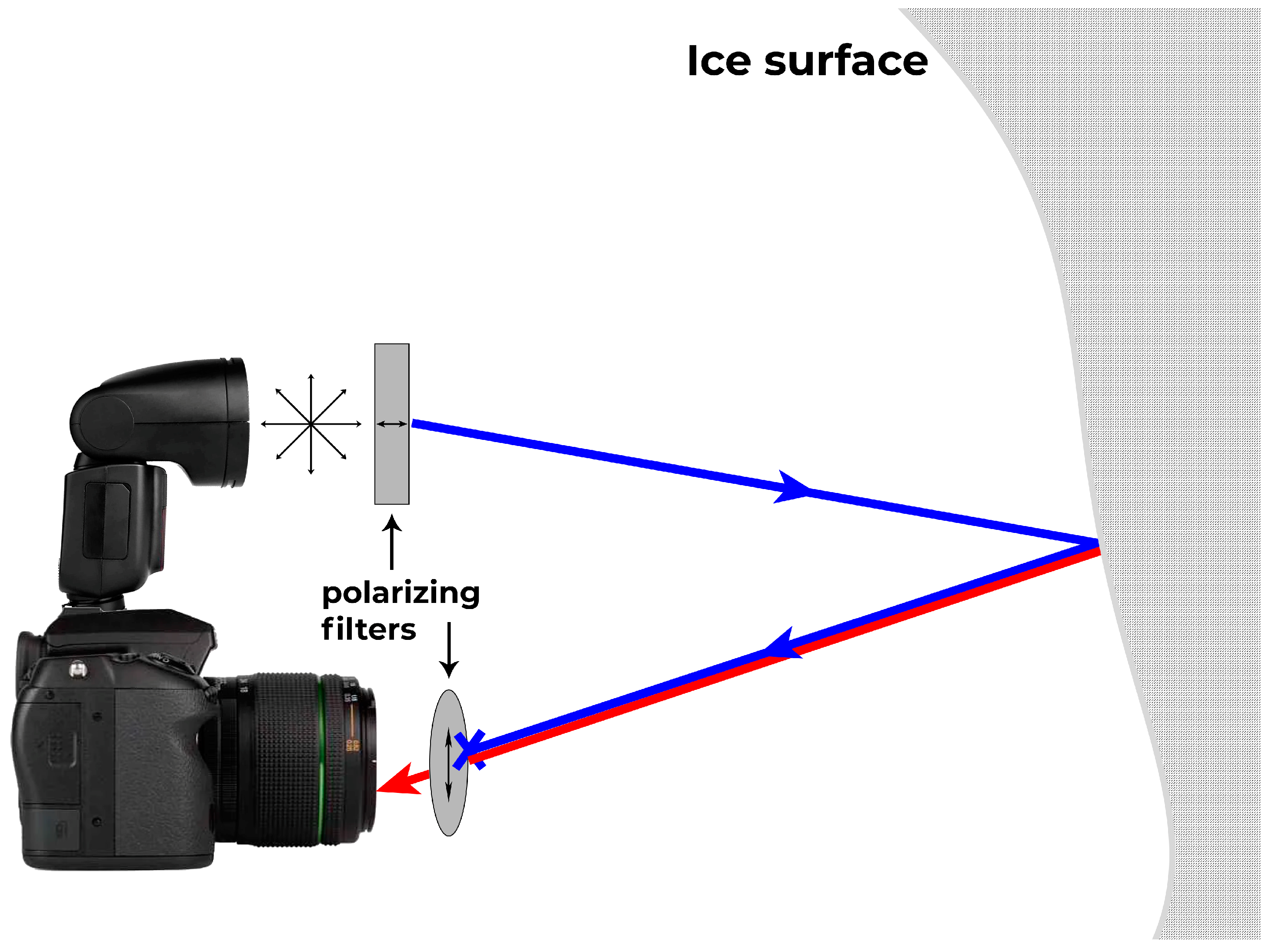
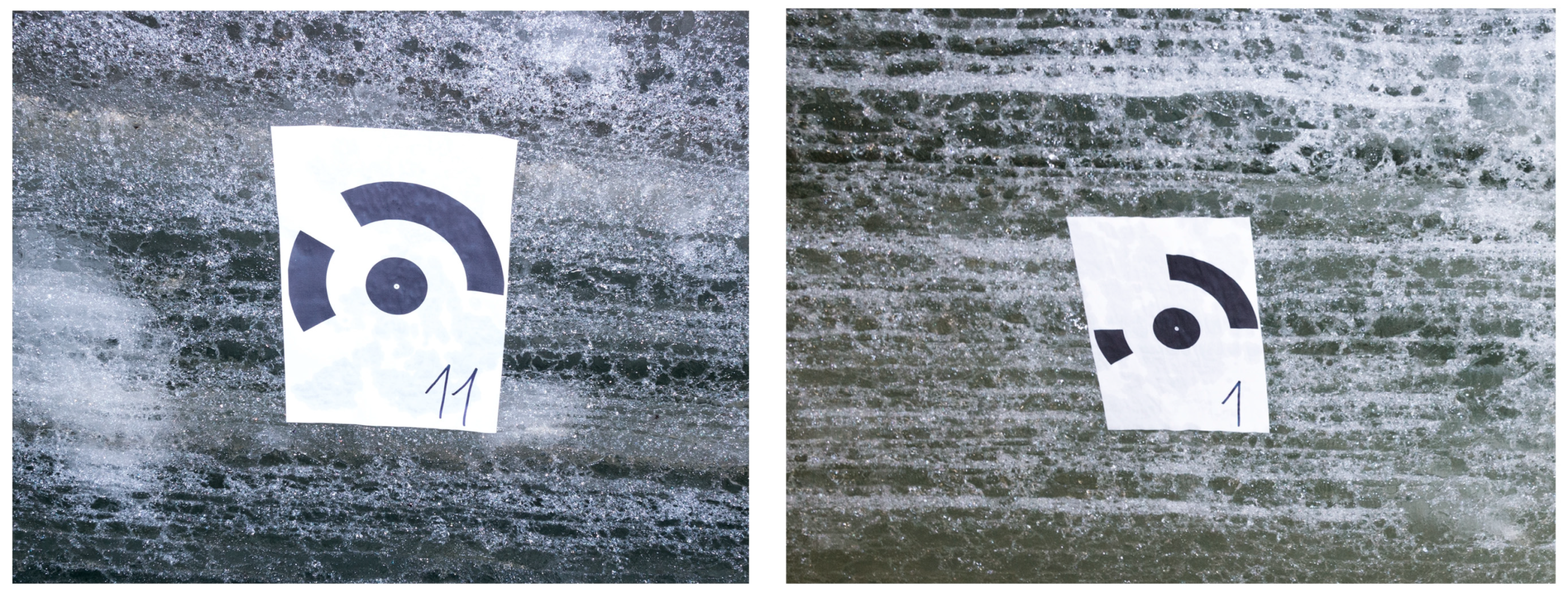
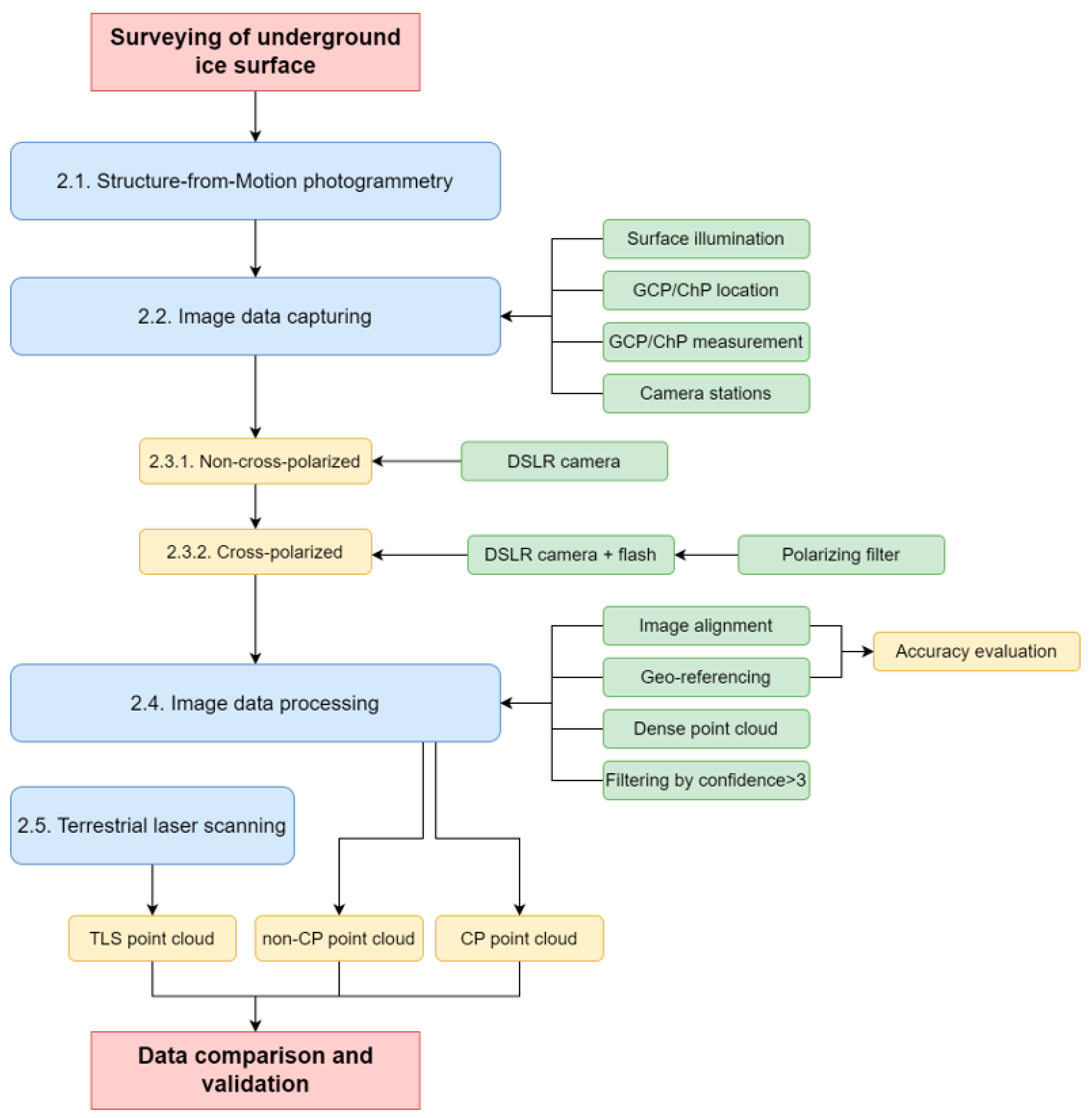
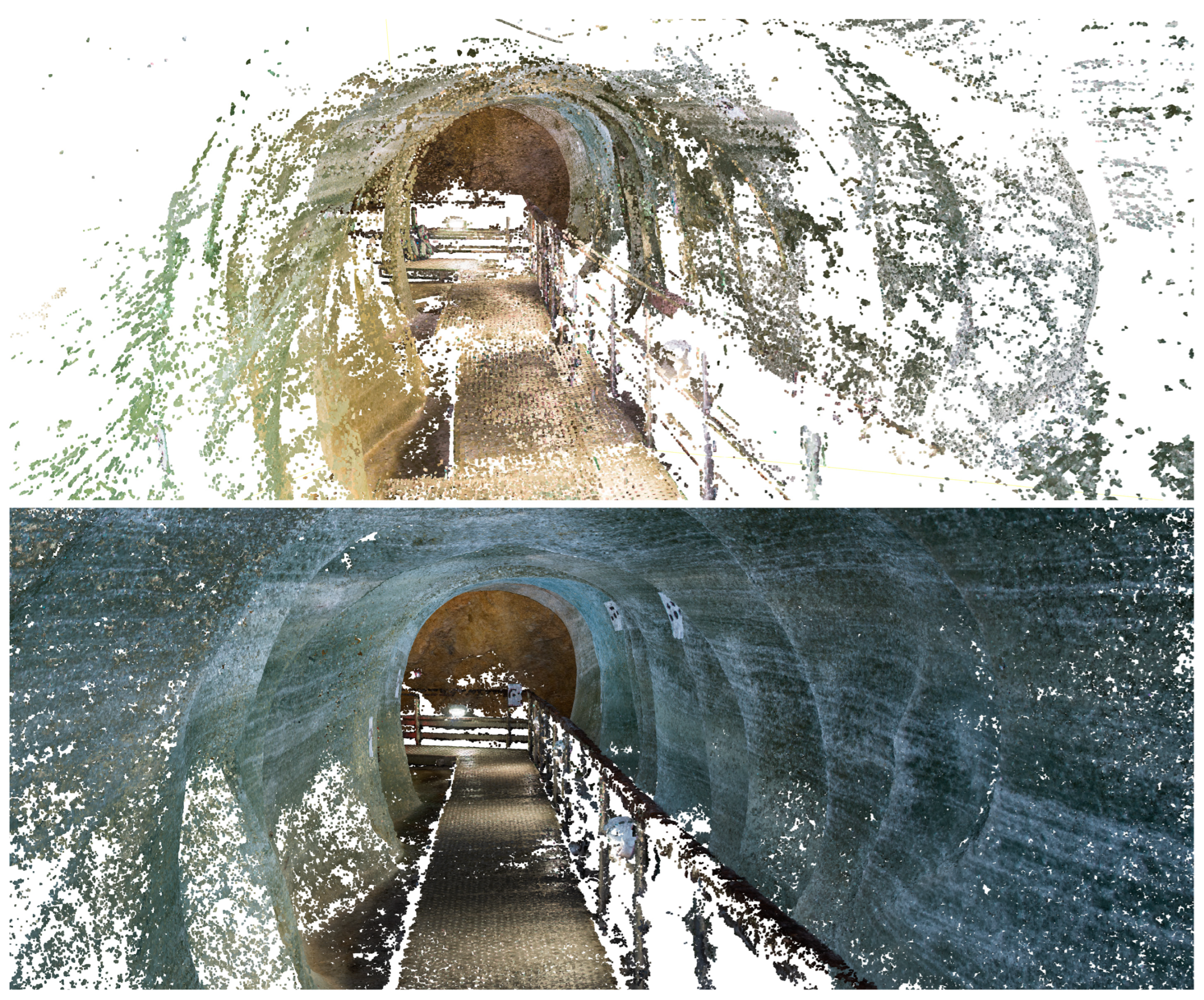
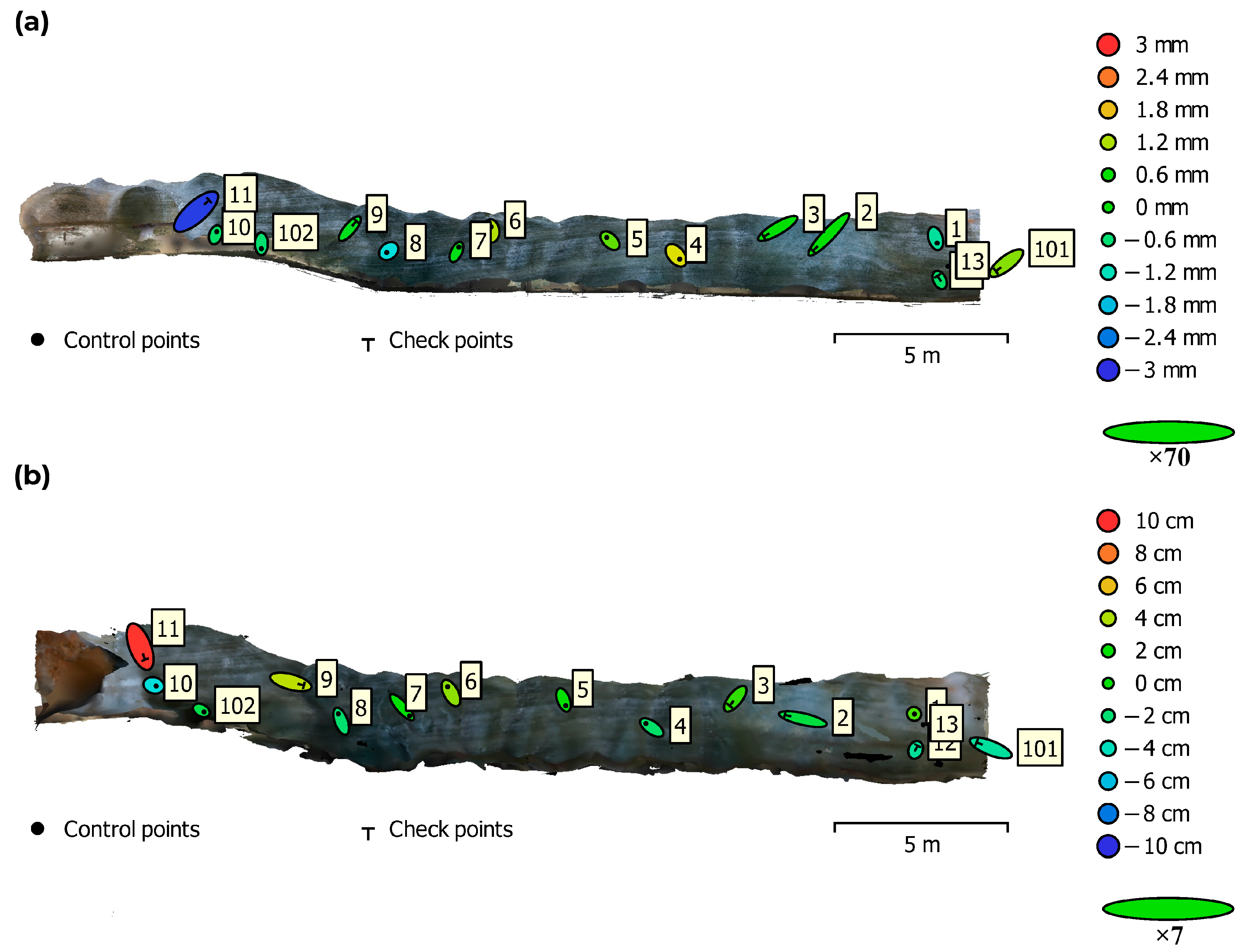
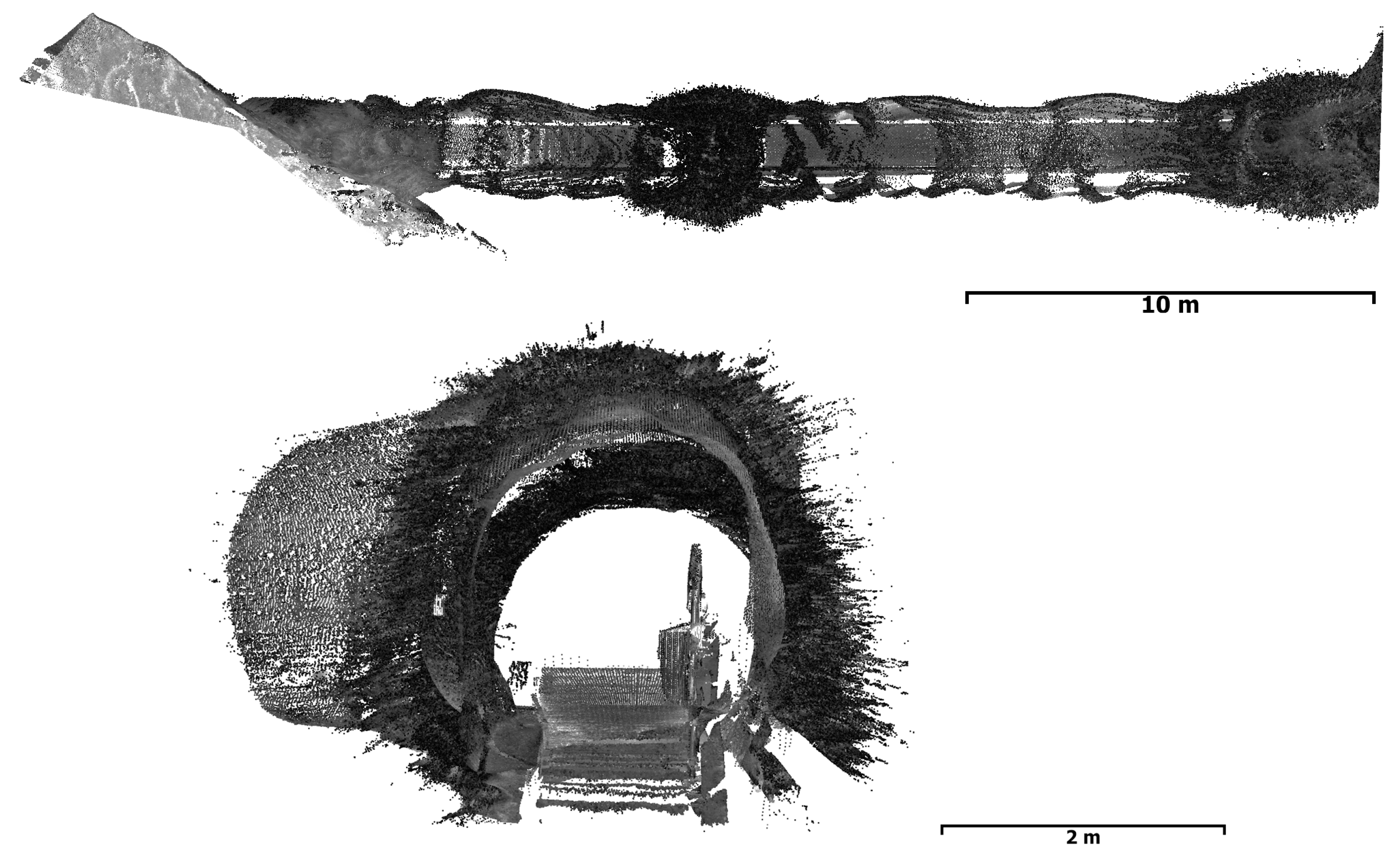
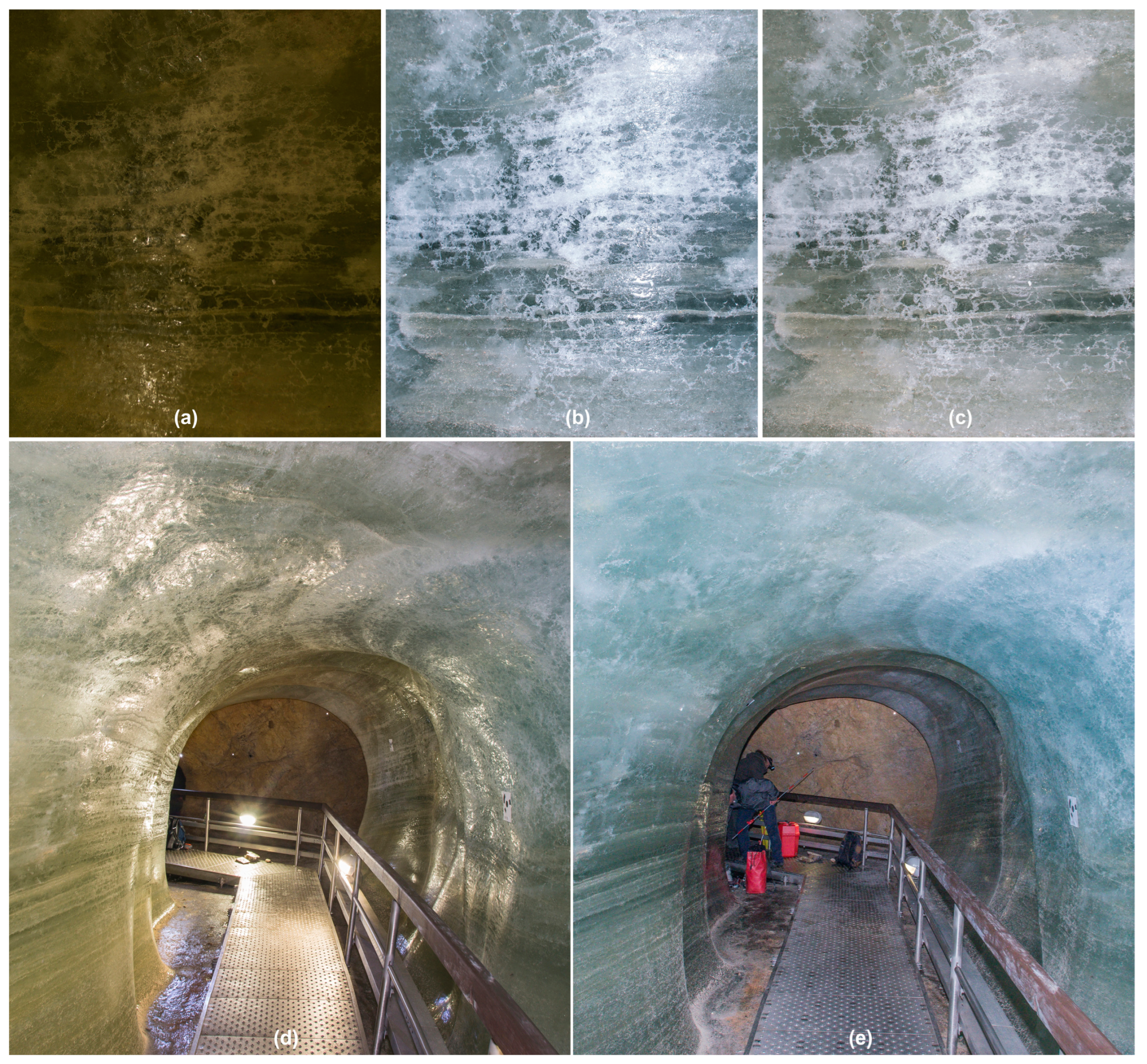
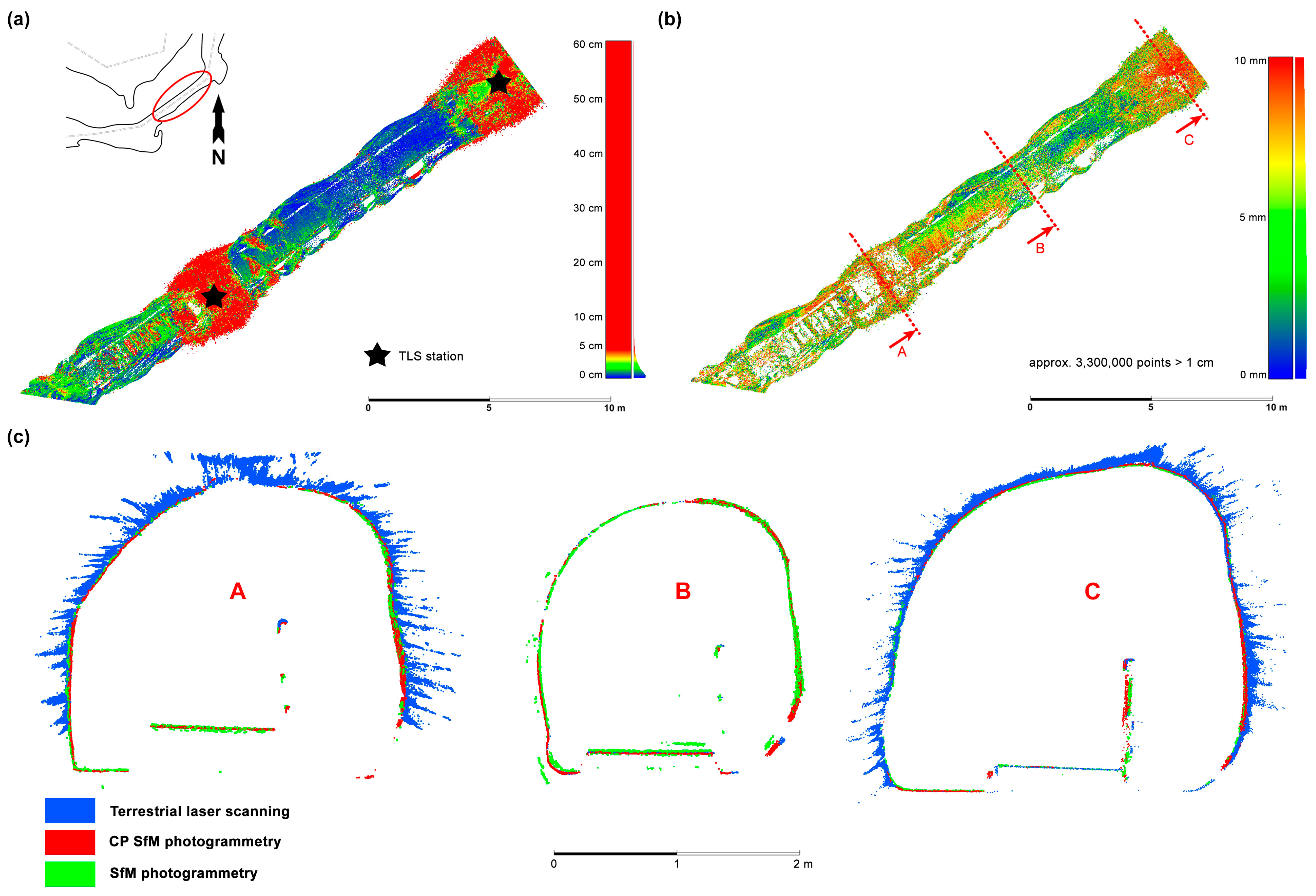
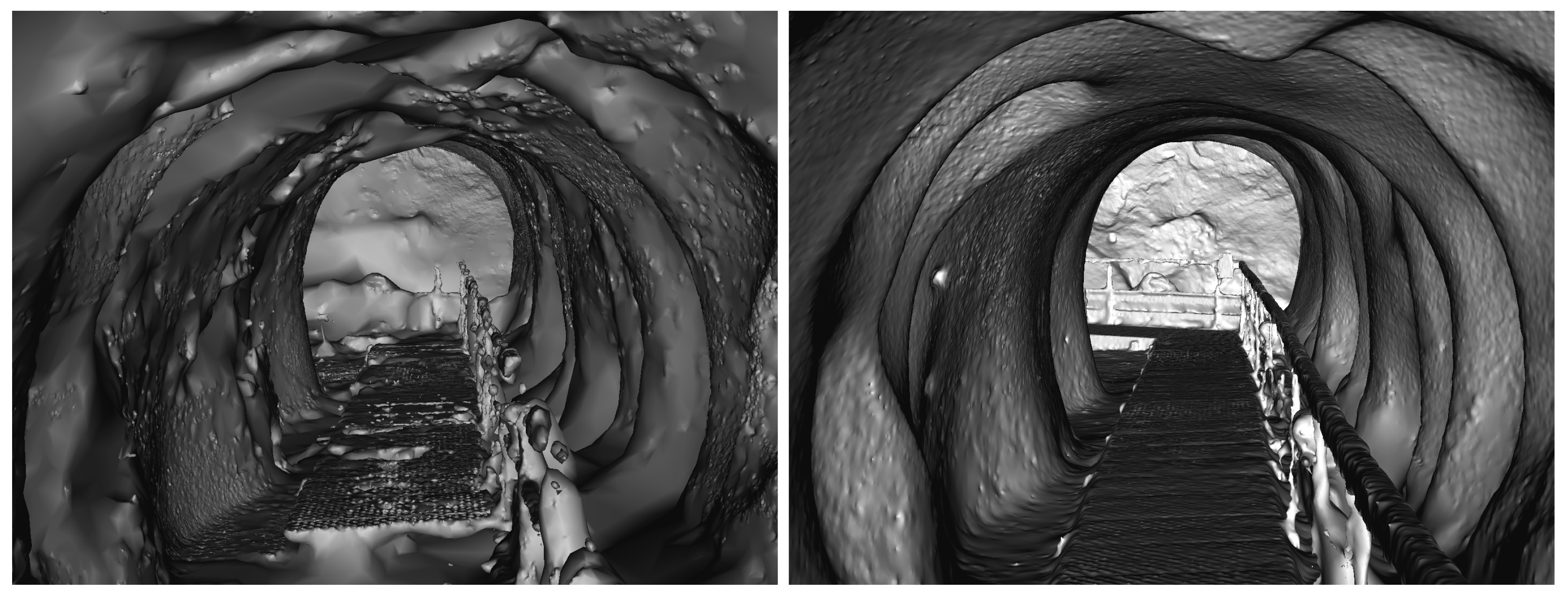
| Camera | |||||
|---|---|---|---|---|---|
| Model | Sensor [mm] | Pixel size [µm] | Resolution [pix] | Focal length [mm] | Format |
| Pentax K-5 | 23.6 × 15.7 | 4.77 | 4928 × 3264 | 15.0 | RAW→Tiff |
| Polarizing filter | |||||
| Transmittance | Efficiency | Polarization axis | Wavelength | Thickness | Reliability |
| Single (42%) Crossed (≤0.005%) | 99.99% | 50mm | 380–700 nm | 0.19 mm | 30–80 °C |
| Align Images | Gradual Filtering |
|---|---|
| Accuracy—high | 1 Reconstruction uncertainty <15 |
| Key point limit—400,000 | 2 Projection accuracy <3 |
| Tie point limit—0 | 3 Reprojection error <0.3 |
| Image coordinates accuracy | Dense cloud generation |
| Marker accuracy—0.1 pix | Quality—high |
| Tie point accuracy—0.3 pix | Depth filtering—moderate |
| Measurement accuracy | Calculate point confidence |
| Marker accuracy—0.005 m |
| Parameters of Imaging and Image Processing | ||
|---|---|---|
| No Polarization | Cross Polarization | |
| No. of used images | 110 | |
| Average imaging distance | 2 m | |
| 1 No. of tie points | 19,836 | 24,492 |
| No. of reconstructed points | 54,000,000 | 70,000,000 |
| 2 No. of points with confidence > 3 | 2,400,000 (4.5%) | 36,000,000 (51%) |
| 3 Ground sample distance | 0.9 mm/pix | |
| 4 Maximal error | 4.492 pix | 3.313 pix |
| 5 Reprojection error | 0.613 pix | 0.515 pix |
| No. of ground control points/checkpoints | 9/6 | |
| Max. residual of GCPs | 1.618 pix | 0.554 pix |
| Max. residual of ChPs | 1.094 pix | 0.607 pix |
| 6 Accuracy in the reference system (total error) | 36 mm | 2 mm |
| Accuracy of checkpoints | 97 mm | 3 mm |
Disclaimer/Publisher’s Note: The statements, opinions and data contained in all publications are solely those of the individual author(s) and contributor(s) and not of MDPI and/or the editor(s). MDPI and/or the editor(s) disclaim responsibility for any injury to people or property resulting from any ideas, methods, instructions or products referred to in the content. |
© 2023 by the authors. Licensee MDPI, Basel, Switzerland. This article is an open access article distributed under the terms and conditions of the Creative Commons Attribution (CC BY) license (https://creativecommons.org/licenses/by/4.0/).
Share and Cite
Bartoš, K.; Pukanská, K.; Kseňak, Ľ.; Gašinec, J.; Bella, P. Cross-Polarized SfM Photogrammetry for the Spatial Reconstruction of Challenging Surfaces, the Case Study of Dobšiná Ice Cave (Slovakia). Remote Sens. 2023, 15, 4481. https://doi.org/10.3390/rs15184481
Bartoš K, Pukanská K, Kseňak Ľ, Gašinec J, Bella P. Cross-Polarized SfM Photogrammetry for the Spatial Reconstruction of Challenging Surfaces, the Case Study of Dobšiná Ice Cave (Slovakia). Remote Sensing. 2023; 15(18):4481. https://doi.org/10.3390/rs15184481
Chicago/Turabian StyleBartoš, Karol, Katarína Pukanská, Ľubomír Kseňak, Juraj Gašinec, and Pavel Bella. 2023. "Cross-Polarized SfM Photogrammetry for the Spatial Reconstruction of Challenging Surfaces, the Case Study of Dobšiná Ice Cave (Slovakia)" Remote Sensing 15, no. 18: 4481. https://doi.org/10.3390/rs15184481
APA StyleBartoš, K., Pukanská, K., Kseňak, Ľ., Gašinec, J., & Bella, P. (2023). Cross-Polarized SfM Photogrammetry for the Spatial Reconstruction of Challenging Surfaces, the Case Study of Dobšiná Ice Cave (Slovakia). Remote Sensing, 15(18), 4481. https://doi.org/10.3390/rs15184481










